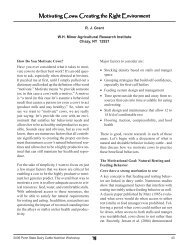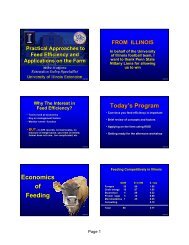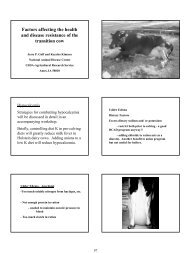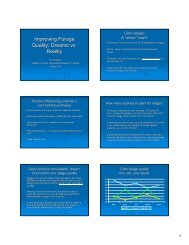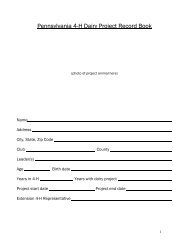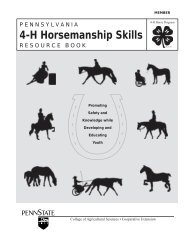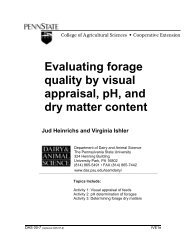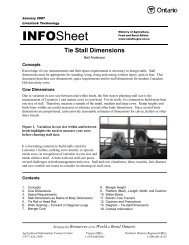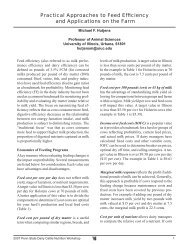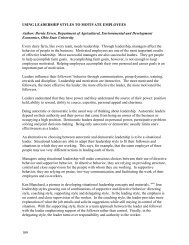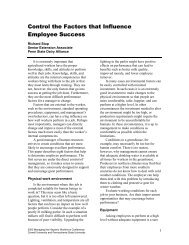DETERMINING THE MINERAL REQUIREMENT OF DAIRY CATTLE
DETERMINING THE MINERAL REQUIREMENT OF DAIRY CATTLE
DETERMINING THE MINERAL REQUIREMENT OF DAIRY CATTLE
You also want an ePaper? Increase the reach of your titles
YUMPU automatically turns print PDFs into web optimized ePapers that Google loves.
suggesting Fe and Zn share a common absorption mechanism. In man the effect of excess<br />
Fe is evident when the Fe:Zn ratio is greater than 2:1. No data exists on the interaction<br />
between dietary Fe and Zn absorption in ruminants. Under practical conditions dietary Fe<br />
content is often well in excess of Fe requirements of herbivores.<br />
Cadmium is antagonistic to the absorption of both Zn and Cu and also interferes with<br />
tissue metabolism of Zn and Cu in the liver and kidneys. Lead competitively inhibits Zn<br />
absorption and also interferes with Zn function during heme synthesis.<br />
High dietary Ca interferes with Zn absorption in non-ruminants (see parakeratosis of<br />
swine). The mechanism is not well understood though it appears to be of greater concern<br />
when diets are high in phytate.<br />
2. Organic chelators of Zn can increase or decrease bioavailability of Zn.<br />
Those that interfere with absorption tend to form insoluble complexes with Zn. One<br />
such chelator is phytate (phytic acid) which is also an important chelator of phosphate.<br />
Phytate commonly binds Zn in plant sources of Zn and greatly diminishes the availability of<br />
Zn for absorption in monogastric and pre-ruminant animals. However, rumen microbes<br />
metabolize most of the dietary phytate so it is not a factor affecting Zn absorption in<br />
ruminating animals. Others remain unidentified.<br />
Some naturally occurring Zn chelators improve Zn bioavailability. Scott and Ziegler<br />
(1963) demonstrated with chicks that adding distillers dried solubles and liver extract to<br />
soybean protein based diets improved the availability of the dietary Zn, though the factor<br />
remained unknown. Peptides and amino acids can form complexes with Zn and both<br />
cysteine and histidine bind Zn strongly and improve bioavailability of Zn in chicks (Nielsen<br />
et al., 1966) (Hortin et al., 1991). At the alkaline pH found in the intestine it is likely that<br />
little free Zn cation exists in solution. One action of beneficial chelates is to form Zn<br />
complexes that are soluble within the small intestine permitting soluble Zn to reach the<br />
brush border membrane for absorption.<br />
Deficiency<br />
Zn deficient animals quickly exhibit reduced feed intake, and reduced growth rate.<br />
With more prolonged deficiency the animals exhibit reduced growth of testes, weak hoof<br />
horn and perakeratosis of the skin on the legs, head (especially nostrils), and neck. On<br />
necropsy thymic atrophy and lymphoid depletion of the spleen and lymph nodes are<br />
evident.<br />
Toxicity<br />
High dietary Zn is fairly well tolerated by cattle, however Zn toxicity was observed in<br />
cattle fed 900 mg Zn / kg diet. High levels of Zn have a very negative effect on Cu<br />
absorption and metabolism and it is for this reason primarily that dietary Zn content should<br />
be limited. The maximal tolerable level of dietary Zn is suggested to be 300- 1000mg/ kg<br />
diet.<br />
Genetic Zn deficiency of cattle<br />
A genetic defect that greatly reduces Zn absorption has been identified in Black Pied<br />
and Dutch-Friesan cattle. These animals become severely Zn deficient unless fed<br />
extremely high levels of dietary Zn. Calves appear normal at birth but develop scaly<br />
thickened skin over the neck and shoulders within a few months. They also grow slowly<br />
and are very susceptible to infection due to their inability to mount an immune response.<br />
52




